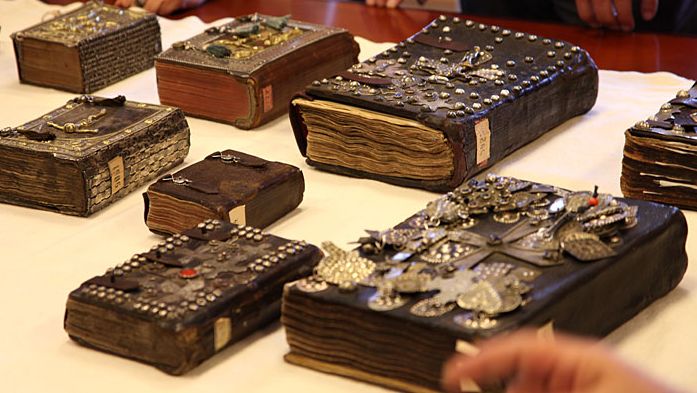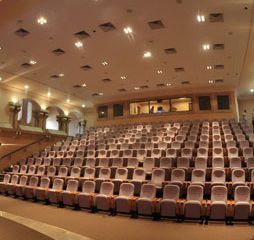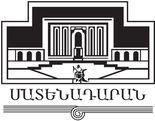
Mesrop Mashtots Matenadaran is a research institute and museum with a valuable manuscript collection.
The history of Matenadaran comes from the depths of centuries because the basis of its collection is the manuscript collection of the Catholicos of All Armenians, Saint Etchmiadzin, which, before moving to Yerevan in 1939, was already called “Matenadaran” (this word means a repository of manuscripts, a storehouse of books, a collection).
Armenian manuscripts have existed in the Armenian Catholicosate since the 5th century when Mesrop Mashtots established it. The Catholicosate has since been settled in different places but steadily maintained a collection of manuscripts. In 1441, the Catholicosate of Armenia was re-established in St. Etchmiadzin, laying the foundation for its library, the collection of which grew over the following centuries.
The regulation of the manuscript collection and the numbering of the books in the Matenadaran of Etchmiadzin began in 1828 when the first brief list of manuscripts was compiled (312). Another more extensive manuscript list was compiled in 1837 (2340). In 1892, there were 3158 manuscripts in the Etchmiadzin Matenadaran, and 21 years later, in 1913, there were 4060 manuscripts.

At the beginning of the First World War, in 1915, out of concern to protect the collection from the danger of war, it was moved to Moscow and kept in the local Armenian church (it was returned to Armenia in 1922). However, that war was devastating for Western Armenia. At the same time, the Armenian Genocide implemented in the Ottoman Empire dealt a tremendous blow to the Armenian culture and manuscript heritage, causing the irretrievable loss of thousands of books. However, with the efforts of Armenian Catholicos Gevorg V Surenyants (1911-1930) and several devoted people, it was possible to transfer to Etchmiadzin in 1915-1916 around 1600 manuscripts brought from Vaspurakan, Mush, Erzurum and saved in different ways.
After the Soviet regime, in 1920, the Matenadaran of Etchmiadzin Cathedral was nationalized by a decree on December 17. In 1939, the manuscript collection was moved to the State Library named after Al. Myasnikyan in Yerevan, which later became the Public Library and now is the National Library. During that time, the collection included 9,690 Armenian manuscripts and 675 manuscripts in foreign languages.

During the Soviet period, a unique building was constructed to safeguard the Armenian culture, including the valuable manuscript heritage. The Matenadaran Museum building, designed by architect Mark Grigoryan, was completed between 1945 and 1959 with exceptional care and attention to detail. After that, Matenadaran was founded in a new building, and on March 3, 1959, it was converted into the Research Institute of Ancient Manuscripts by the decision of the Soviet Armenian Government. During this period, Levon Khachikyan, the director of the Matenadaran, played a crucial role in establishing it as a research institute, achieving international recognition very soon. In 1962, the institution was named after Mesrop Mashtots, the creator of Armenian writing.
In 2011, a new and spacious research building was constructed for Matenadaran due to the expansion of its activities and growth of its collection, designed by architect Arthur Meschyan.
Today, Matenadaran houses approximately 20,000 manuscripts in Armenian and other languages. These manuscripts cover ancient and medieval Armenian science and culture, including history, geography, grammar, philosophy, law, medicine, mathematics, cosmology, calendar science, translated and national literature, miniature painting, music, and theatre. Matenadaran is a repository of ancient manuscripts, holding a vast collection of manuscripts in various languages such as Armenian, Greek, Arabic, Persian, Assyrian, Latin, Ethiopian, Georgian, Hebrew, and others. The Armenian translations made in the Middle Ages are particularly significant because they have helped preserve many original works that were not saved in their native languages and are now only known through Armenian translations. Along with academic research, restoration of manuscripts and various publishing works, Matenadaran continues collecting manuscripts through donations and purchases. Academician Levon Khachikyan (1954-1982), academician Sen Arevshatyan (1982-2007), and doctor of philological sciences Hrachya Tamrazyan (2007-2016) were directors of Matenadaran. In 2016-2023, the director of Matenadaran was Vahan Ter-Ghevondian, a doctor of historical sciences. Arayik Khzmalyan, a candidate of arts, was elected to that position on July 17, 2023. Matenadaran had the status of SNPO from 2002 to 2017, after which it became a state fund. Matenadaran was registered in UNESCO’s “World Memory” list in 1997 and is considered one of the most important places for the preservation and development of Armenian national memory. Matenadaran is a prominent institution in Armenia that houses the intellectual heritage of its people. It is well-respected on the global stage and serves as a research institute and a museum. Today, it is considered one of the most important landmarks in the capital city of Yerevan.
